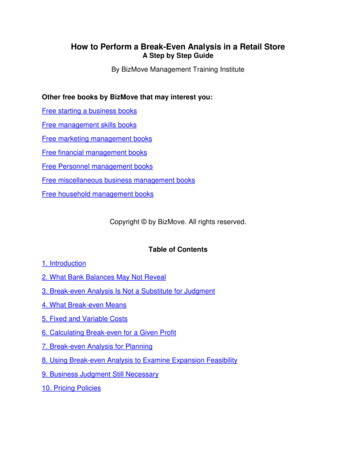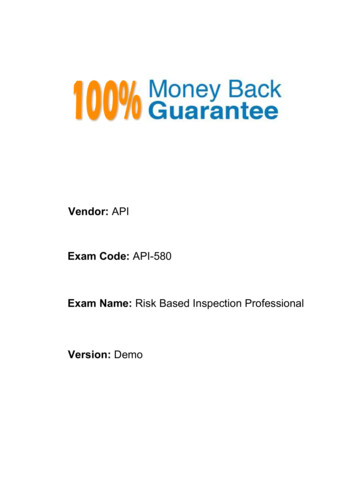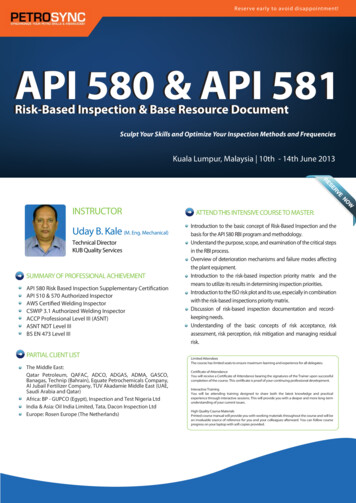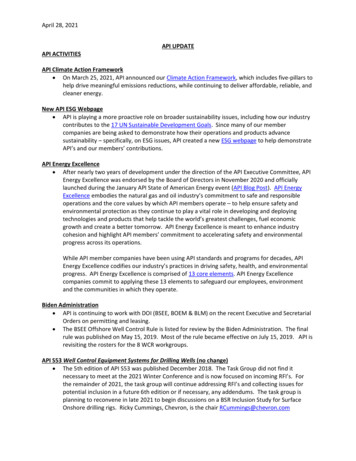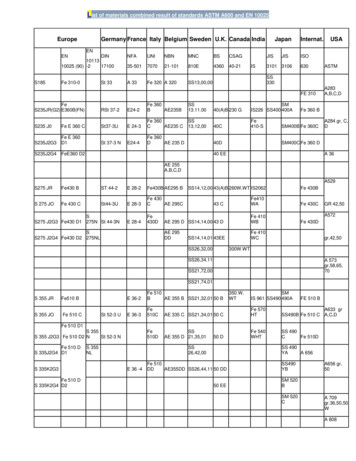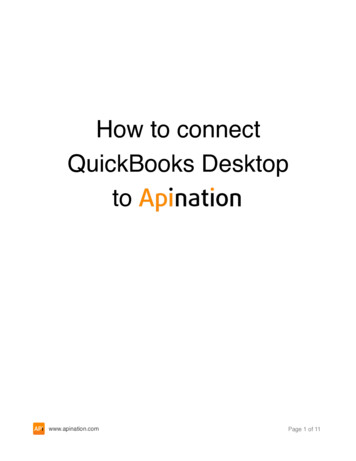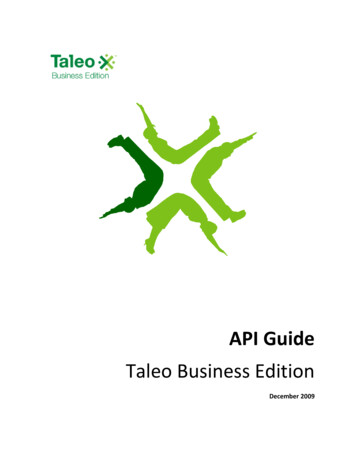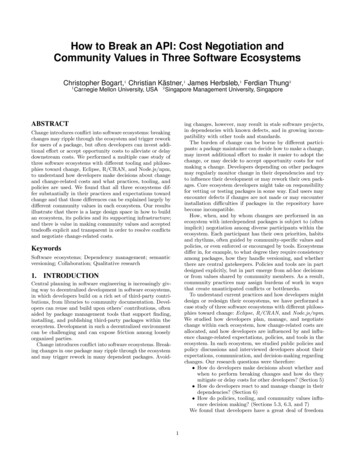
Transcription
How to Break an API: Cost Negotiation andCommunity Values in Three Software EcosystemsChristopher Bogart,1 Christian Kästner,1 James Herbsleb,1 Ferdian Thung21Carnegie Mellon University, USA2Singapore Management University, SingaporeABSTRACTing changes, however, may result in stale software projects,in dependencies with known defects, and in growing incompatibility with other tools and standards.The burden of change can be borne by different participants: a package maintainer can decide how to make a change,may invest additional effort to make it easier to adopt thechange, or may decide to accept opportunity costs for notmaking a change. Developers depending on other packagesmay regularly monitor change in their dependencies and tryto influence their development or may rework their own packages. Core ecosystem developers might take on responsibilityfor vetting or testing packages in some way. End users mayencounter defects if changes are not made or may encounterinstallation difficulties if packages in the repository havebecome incompatible.How, when, and by whom changes are performed in anecosystem with interdependent packages is subject to (oftenimplicit) negotiation among diverse participants within theecosystem. Each participant has their own priorities, habitsand rhythms, often guided by community-specific values andpolicies, or even enforced or encouraged by tools. Ecosystemsdiffer in, for example, to what degree they require consistencyamong packages, how they handle versioning, and whetherthere are central gatekeepers. Policies and tools are in partdesigned explicitly, but in part emerge from ad-hoc decisionsor from values shared by community members. As a result,community practices may assign burdens of work in waysthat create unanticipated conflicts or bottlenecks.To understand current practices and how developers mightdesign or redesign their ecosystems, we have performed acase study of three software ecosystems with different philosophies toward change: Eclipse, R/CRAN, and Node.js/npm.We studied how developers plan, manage, and negotiatechange within each ecosystem, how change-related costs areallocated, and how developers are influenced by and influence change-related expectations, policies, and tools in theecosystem. In each ecosystem, we studied public policies andpolicy discussions and interviewed developers about theirexpectations, communication, and decision-making regardingchanges. Our research questions were therefore: How do developers make decisions about whether andwhen to perform breaking changes and how do theymitigate or delay costs for other developers? (Section 5) How do developers react to and manage change in theirdependencies? (Section 6) How do policies, tooling, and community values influence decision making? (Sections 5.3, 6.3, and 7)We found that developers have a great deal of freedomChange introduces conflict into software ecosystems: breakingchanges may ripple through the ecosystem and trigger reworkfor users of a package, but often developers can invest additional effort or accept opportunity costs to alleviate or delaydownstream costs. We performed a multiple case study ofthree software ecosystems with different tooling and philosophies toward change, Eclipse, R/CRAN, and Node.js/npm,to understand how developers make decisions about changeand change-related costs and what practices, tooling, andpolicies are used. We found that all three ecosystems differ substantially in their practices and expectations towardchange and that those differences can be explained largely bydifferent community values in each ecosystem. Our resultsillustrate that there is a large design space in how to buildan ecosystem, its policies and its supporting infrastructure;and there is value in making community values and acceptedtradeoffs explicit and transparent in order to resolve conflictsand negotiate change-related costs.KeywordsSoftware ecosystems; Dependency management; semanticversioning; Collaboration; Qualitative research1.INTRODUCTIONCentral planning in software engineering is increasingly giving way to decentralized development in software ecosystems,in which developers build on a rich set of third-party contributions, from libraries to community documentation. Developers can reuse and build upon others’ contributions, oftenaided by package management tools that support finding,installing, and publishing third-party packages within theecosystem. Development in such a decentralized environmentcan be challenging and can expose friction among looselyorganized parties.Change introduces conflict into software ecosystems. Breaking changes in one package may ripple through the ecosystemand may trigger rework in many dependent packages. Avoid-1
2.Platform &Communitywhen assigning or delaying costs of changes within an ecosystem. At the same time, expectations about how to handlechange differ significantly among the three ecosystems andinfluence cost-benefit tradeoff decisions among developersand users. These differences are rooted in community valuesand are reinforced through peer pressure, policies, and tooling, as we will describe. For example, long-term stability isa key value of the Eclipse community: this shifts costs to thedevelopers making the change, who may go to great length toaccept opportunity costs and technical debt to avoid breaking client code. In contrast, the Node.js/npm communityvalues ease for developers and has a technical infrastructure in which developers are less concerned about breakingchanges as long as they are signaled clearly through versionnumbering. We hypothesize that clarifying how policies servecore community values can facilitate decision making andfocused deliberation over policies and values.In summary, we contribute a case study of three softwareecosystems, contrasting their change-related practices, values,policies, and tools. Our results have implications for understanding how stakeholders can influence change negotiationand design or change software ngesnotificationsselect dependenciesbug reports, pull requestsmonitoringDownstreamFigure 1: Conceptual overview of “upstream” and “downstream” distinction and influence of platform and community.mation hiding [37] and a key design principle, but cannotalways protect against unanticipated change at scale in practice [35, 46]. Traditional centralized change control or changemanagement approaches (such as change control boards androadmapping [15, 44]) break down with the dynamic anddistributed nature of software ecosystems. Tools for changeimpact analysis [2, 49] face challenges with the distributednature, the openness, and the scale of software ecosystems.Change in software ecosystems can therefore be unexpected and disruptive, but practices and tools have emergedfor upstream developers to alert users and help them adapt.Developers use social media such as Twitter, blogs, mailinglists, and chat to directly communicate relevant recent orupcoming changes [7,19,43]. Semantic versioning is a popularversioning strategy to signal the compatibility of a changethrough version numbers: changes in the major version indicate breaking API changes, whereas changes to minor andpatch version are intended as backward compatible [38, 40].Transparent environments, such as GitHub [7], enable usersto follow and comment on changes. Tools like YooHoo [21],NeedFeed [36], gemnasium [17] and greenkeeper [18] use different strategies to automatically filter what is relevant to aparticular downstream project out of voluminous upstreamactivity streams. Once downstream users are aware of relevant changes, they may collaborate directly with upstreamdevelopers to get help with changes [7, 19]. Tools have beenproposed to make breaking changes less disruptive by makingit easy to apply patches to downstream products [14, 20].Among different developer communities, different valuescan lead to different policies and practices. For example,Murphy-Hill et al. found that creativity and communicationwith non-engineers is valued more by game developers thanby application developers, resulting in less testing and architecture focus in game development [32]. In the broadercontext of business platforms, Boudreau and Hagiu showways that the rules and mechanisms of business platformsenable different interactions among participants and affectthe platform’s business value [3].Overall though, little is known about how the policies andtools of a software ecosystem reflects or influences the valuesof the developers in the ecosystem’s domain. Tiwana et al.describe the problem abstractly and call for more work on howgovernance, architecture, and other factors cause ecosystemsto evolve [47]. Izquierdo and Cabot have begun mappingthe design space for governance in open-source communitiesfor managing change [4] and O’Mahony investigated theevolution of software ecosystem governance [33], but neitheraddress how a community’s values and policies allocate costamong participants. In this paper, we investigate the decisionsdevelopers make with respect to breaking changes to see howthe different values play out at the smallest scale and relateto ecosystem-wide policies and values.STATE OF THE ARTIn this paper, we study breaking changes between packages insoftware ecosystems. While all changes may incur costs to adownstream maintainer for vetting the updates, we consideras breaking changes those changes that trigger rework fordownstream users. Changes to a package’s API are especiallylikely to break clients that rely on the API. Note that breaking changes include also changes regarding behavior andperformance expectations, not just changes to an interface’smethod signatures. A software ecosystem is “a set of actorsfunctioning as a unit and interacting with a shared market forsoftware and services, together with the relationships amongthem; . frequently underpinned by a common technologicalplatform or market” [48]. Software ecosystems enable supplychains on a shared technology platform, often including anonline repository and a local package management system.From the perspective of an individual developer workingon a package, we distinguish upstream packages on whichthe package depends and downstream packages that use thepackage, as illustrated in Figure 1.In practice, breaking changes are common. Change insoftware systems has been studied, measured, and modeledintensively for many decades [9, 15, 26, 28, 50, 54]. Throughout a large body of research, all studied real-world systemsevolved in unanticipated ways with rippling consequencesacross modules [6, 15, 22, 24, 27, 30, 31, 39–41]. For example,Cossette et al. have shown that Java libraries “frequentlyand seriously change over time” [6, 24]. Decan et al. foundthat about 1 in every 20 updates to a CRAN package wasa backward incompatible change, accounting for 41% of theerrors in released packages that depended on them [11]. Complicated and changing dependencies are a pain point formany developers [1] and have led to common expressionslike “DLL hell” and “dependency hell”. Although packagemanagers are designed to structure the problem by makingdependencies and versions explicit [1, 25, 29], they themselvesare complicated and cannot prevent the problem of ripplingconsequences of breaking changes.Preplanning to shield anticipated change in hidden partsbehind a stable interface is the key principle behind infor2
ipseProgramming tools/HCISoft. Eng./CS EducationSoft. Eng./ResearchCS EducationSoftware engineeringSoftware engineeringEclipse infrastructureSoftware engineeringSoftware CRANSoil scienceStatisticsMedical imagingGeneticsSoil scienceWeb appsData analysisR infrastructureR infrastructureR onyTools for API dev.Web frameworkWeb frameworkCognitive ScienceDatabase, Node infrastr.Database, Node tartupIndustryWe conducted semistructured phone interviews that lasted30–60 minutes. We generally followed an interview scriptshown in Supplement A, but tailored our questions towardthe interviewees’ personal experiences. With the interviewees’consent, we recorded all interviews. We then transcribed themand used a grounded, iterative approach to coding. In ouranalysis, we distinguish between decisions made as upstreamand downstream developer, as depicted in Figure 1, where aninterviewee often held both roles. We tentatively coded thetranscripts looking for interesting themes, then iterativelydiscussed, redefined, and recoded. Once we settled on a set ofcodes, we recoded all transcripts from scratch with at leasttwo researchers coding each transcript. To complement ourinterviews, we explored policies, public discussions, meetingminutes, and tools in each ecosystem. Several intervieweespointed us to additional documents and tools.Validity check. To validate our findings, we adapted Dagenais and Robillard’s methodology [8] to check fit and applicability as defined by Corbin and Strauss [5, p. 305]. Wepresented interviewees with both a summary and a full draftof Sections 4–7, along with questions prompting them to lookfor correctness and areas of agreement or disagreement (i.e.,fit), and any insights gained from reading about experiencesof other developers and platforms (i.e., applicability).Six of our interviewees responded with comments on theresults; all six indicated general agreement (e.g., “It bringsa structure and coherence to issues that I was loosely awareof, but that are too rarely the centre of focus in my everydaywork.”); some corrected small factual errors, (e.g., the numberof CRAN packages had passed 8000 since we initially wroteSection 4); and a few found ways to sharpen our analysis(e.g., R7 noted that CRAN’s policy to contact downstreamdevelopers does not apply to the majority of users outsideCRAN). We incorporated their feedback when it was consistent with a recheck of our data and added clarificationsotherwise.Table 1: Interviewees. R2 and N4 were interviews with pairsof close collaborators, identified as R2a, R2b, N4a, and N4b.3.METHODSWe performed a multiple case study, interviewing 28 developers in the three ecosystems. Case studies are appropriate forinvestigating “how” and “why” questions about current phenomena [55]. We selected three contrasting cases to aim fortheoretical replication [55], a means to investigate the proposition that phenomena will differ across contrasting cases forpredictable reasons. Eclipse and Node.js/npm serve as casesthat contrast sharply in their approach to change: Eclipsehas interfaces that have not changed for over a decade, whileNode.js/npm is a relatively new and fast-moving platform.We expected that Eclipse’s policies and tools might imposecosts on developers in a way that encouraged them to actconsistently with the ecosystem’s values of stability. TheR/CRAN ecosystem serves as a useful third theoretical replication, since its policy favors compatibility among the latestversions of packages over Eclipse’s long-term compatibilitywith past versions. In addition, CRAN acts as a gatekeeperfor a centralized repository in contrast to npm’s intentionallylow hurdles for contributions.We pursued two complementary recruitment strategies forour interviews. Initially, to find individuals with relevant andrecent experiences, we mined repositories to identify packageswith multiple upstream and downstream dependencies andmany changes in 2014 or 2015. Our interviews focused on theirpersonal practices and experiences negotiating upstream anddownstream dependencies. Subsequently, seeking to gain additional insights into the origins and impacts of ecosystem policies, we recruited 8 additional participants, seeking developers with some role (current or historical) in the developmentof the ecosystem’s tools or policies, and adding interview questions about the ecosystem’s history, policy, and values. All28 interviewees were active software developers with multipleyears of experience, but their background ranged from university research to startup companies; Table 1 gives an overview.Threats to Validity. Our study exhibits the threats tovalidity that are typical and expected of qualitative casestudies. The three cases may be atypical, and so one needsto be careful when generalizing beyond the three cases. Ourresults may be affected by a selection bias, in that developerswho did not want to be interviewed may have had differentexperiences. Finally, the differences we found among casesmay be confounded with the reasons we selected them, suchas their popularity or the availability of data about them.4.CASE OVERVIEWTo understand the identified different practices and policies,it is important to understand the purpose and history of eachecosystem. In the following, we provide a brief descriptionof all three ecosystems and their values, informed by bothpublic documentation and our interviews.4.1EclipseThe Eclipse foundation publishes more than 250 open sourceprojects. Its flagship project is the Eclipse IDE, created in2001. The IDE is built from the ground up around a pluginarchitecture, which can be used as a general purpose GUIplatform and in which plugins can depend on and extendother plugins. Projects can apply to join the Eclipse foundation through an incubation process in which their projectand practices come under the Eclipse management umbrella.3
It is also common practice to develop both commercial andopen-source packages separately from the foundation, andpublish them in a common format on a third-party server. Inaddition, the “Eclipse marketplace” is a popular registry, listing over 1600 external Eclipse packages that can be installedfrom third-party servers through a GUI dialog.The Eclipse foundation coordinates a “simultaneous release” of the Eclipse IDE once a year and (as of 2016) three“update releases” for new features in between. Many externaldevelopers align with those dates as well.The Eclipse foundation is backed by many corporate members, including IBM, SAP, and Oracle. Its policies are biasedheavily toward backward compatibility, where one can oftenexpect that packages (e.g., commercial business solutions)developed 10 years ago will still work in a current Eclipserevision without modification.A core value of the Eclipse community is backwardcompatibility. This value is evident in many policies, suchas “API Prime Directive: When evolving the Component APIfrom release to release, do not break existing Clients” [13].Although not entirely uncontroversial (as we will explain),this value was confirmed by many interviewees.4.2applications released initially in 2009, and npm is its defaultpackage manager. npm provides tools for managing packagesof JavaScript code and an online registry for those packagesand their revisions. The npm repository contains over 250,000packages with rapid growth rates.The Node.js/npm platform has the somewhat unusualcharacteristic that multiple revisions of a package can coexistwithin the same project. That is, a user can use two packagesthat each require a different revision of a third package. Inthat case, npm will install both revisions in distinct placesand each package will use a different implementation.A core value of the Node.js/npm community is tomake it easy and fast for developers to publish anduse packages. In addition, the community is open to rapidchange. Ease for developers was one of the principles motivating the designer of npm [45]. Therefore, npm explicitly doesnot act as a gatekeeper; it does not have review or testingrequirements; in fact the
a backward incompatible change, accounting for 41% of the errors in released packages that depended on them [11]. Com-plicated and changing dependencies are a pain point for . E6 Eclipse Software engineering Industry E7 Eclipse Eclipse infrast
![API Ballot: [Ballot ID] – API 510 & API 570, Deferrals, Rev05](/img/5/api510andapi570deferralsrev5.jpg)

